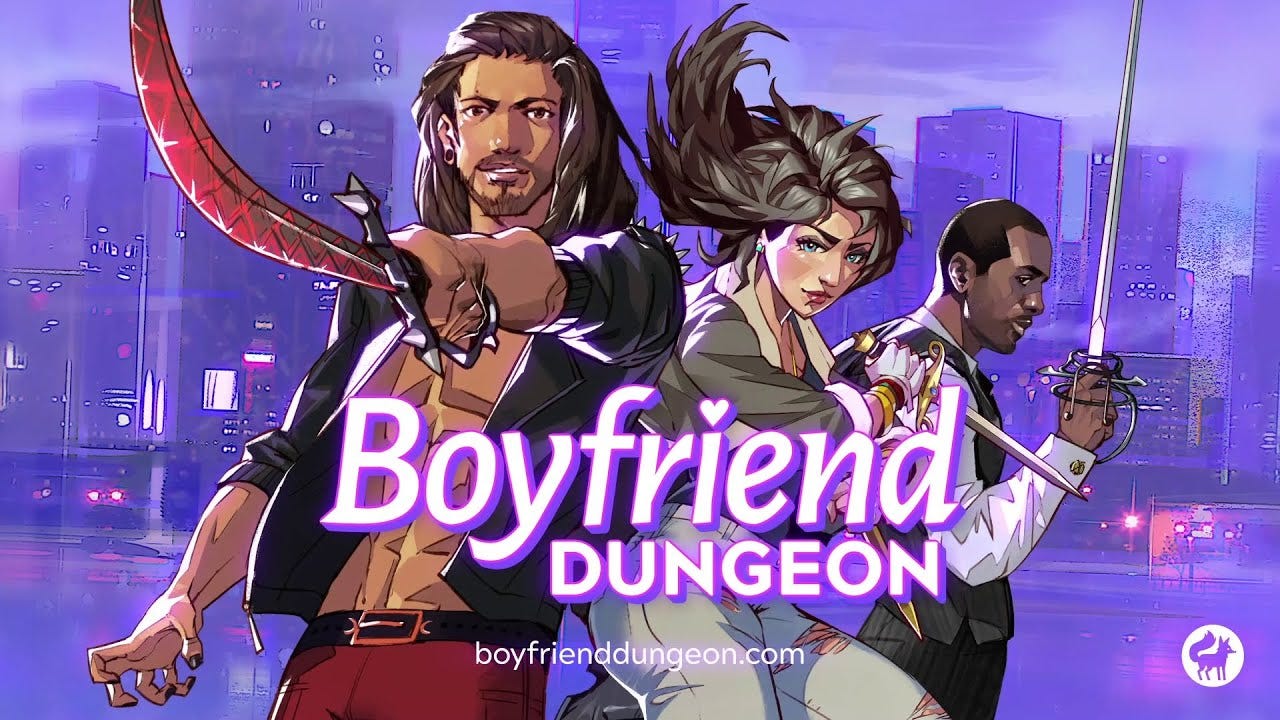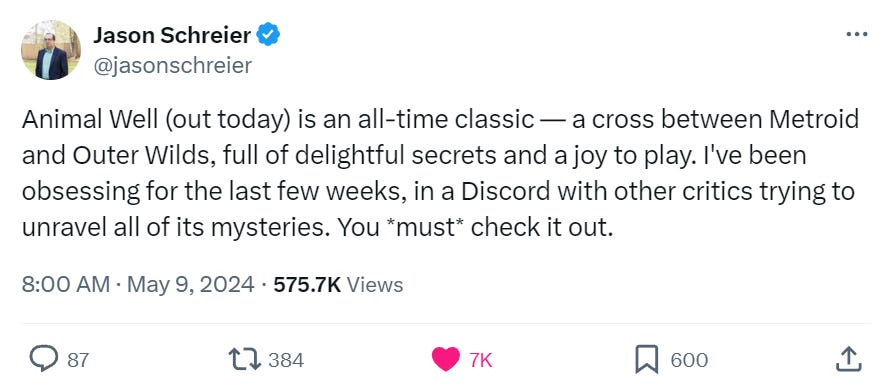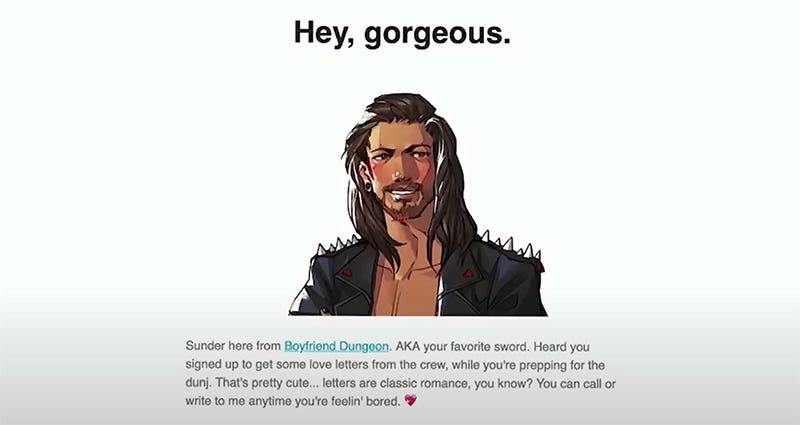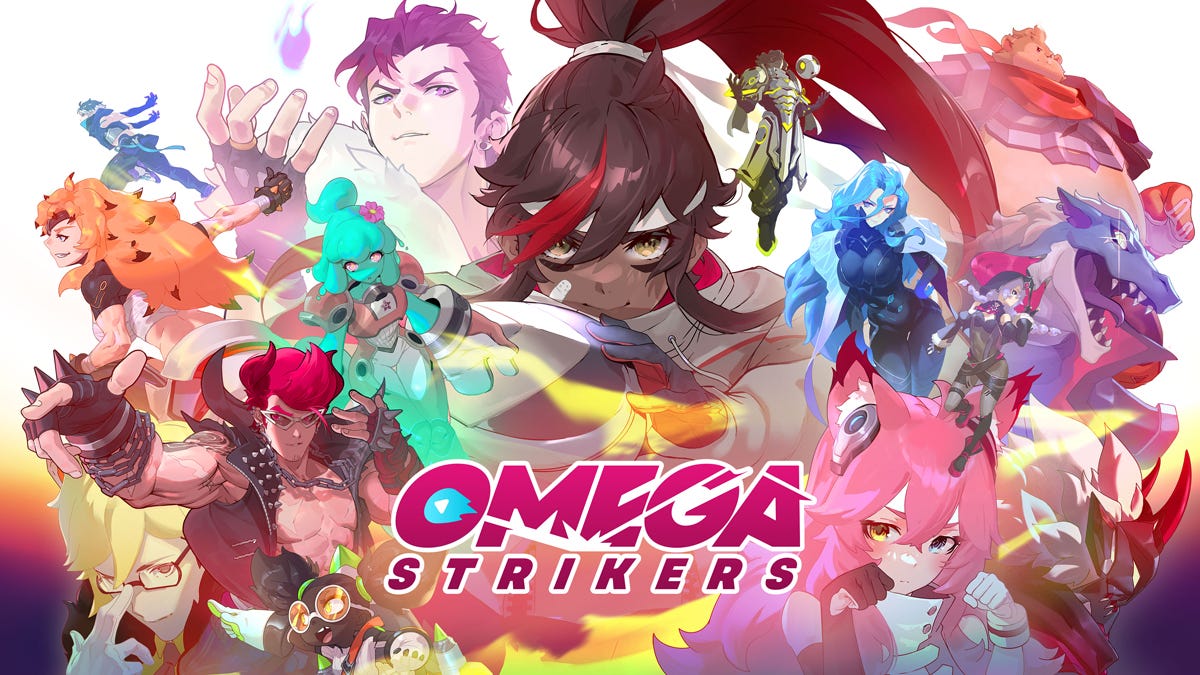Game Marketing Ideas Worth Stealing
push to talk #29 // look let's not be weird about this we all do it
Recently I’ve been writing a bunch of lengthy, abstract rants about video game marketing concepts. To recap, we had:
Games Marketing on Easy Mode, Hard Mode, and the Dark Valley Between - An essay analyzing games that have an easy time getting attention… versus those that struggle to get anyone to care. Includes real talk about how design choices limit your total addressable market.
5 Hard To Swallow Pills For Better Game Positioning - Market positioning is a pretty boring topic. but this post was really popular, I think because it’s fun to think through aspects of marketing that nobody fully understands.
Nobody Knows If Your Game Will Pop Off - A 3,598-word shitpost about spreadsheet wizards and the terrifying possibility that the only way to do successful things is to also do lots of unsuccessful things.
For today’s post I wanna get a little more tactical. We love tactics, don’t we folks? *Sucks air through teeth.* A lot of people are saying “oh, strategy, what’s our marketing strategy?” *Does that thing with the hands.* But sometimes we just wanna do some tactics, don’t we?
By tactics, what I really mean are specific marketing ideas you can take and modify for your own uses. And the best way to get ideas—let’s just admit it—is to steal them.
So today, we’re looking at three ideas, taken from three different games. If readers like this format, I’ll make it a recurring series.
Let’s get into it.
#1 - How Animal Well Built a Pre-Release Community for Media
Remember when Dunkey was like “I’m gonna become a games publisher except I’ll be a good one because I’ll only publish good games” and then a lot of people laughed at him?
Yeah… well, since then Dunkey’s label BIGMODE has published exactly one game, ANIMAL WELL, which has a 91 on Metacritic, earning it a “universal acclaim.”
If you find that annoying, or your gut reaction is to go okay well that’s only the one game and he didn’t even like MAKE it just published it so like whatever, then I have some bad news for you: our boy Dunk also busted out some legit innovative marketing tactics to promote this game. And I’m not just talking about his ridiculous door-to-door CS:GO and VRChat promo campaign:
If you look into the details of BIGMODE’s ANIMAL WELL campaign, you’ll find a bunch of stuff like Dunkey going to tons of conventions to promote the game in-person. The BIGMODE team—which is co-led by Dunkey’s wife Leah—did a ton of classic, shoe-leather marketing.
But the specific tactic I wanna talk about is one that only leaked out because press started talking about it: BIGMODE built a private, pre-release Discord server for press and critics specifically so they could discover and discuss the game’s many secrets together, naturally getting each other more excited in the process.
Bloomberg’s Jason Schreier was the first person I saw talking publicly about this:
Plenty of game devs set up Discord channels to host preview events for games. I’ve been involved with similar channels on League of Legends, Apex Legends, and at least one other game that didn’t have Legends in the name. But that’s not the part of this that strikes me as brilliant.
What I find interesting about this approach is that it was set up specifically because the BIGMODE team knew that ANIMAL WELL was the kind of game that required an online community to fully unlock its potential. It’s got weird secrets and totally unintuitive mechanics that you could miss if you’re just going through it blind. It’s the kind of mystery-filled game that would have had a bangin’ forum on GameFAQs.com back in the day.
So by giving reviewers time to stew together in a little micro-community in the weeks leading up to release, Dunkey and co created an environment that actually helped the media understand the game’s true potential in a way they otherwise might have missed.
Despite my clickbait headline, I don’t actually think you should just copy this idea 1:1. The brilliance of the tactic was that it was customized to the specific needs and strengths of ANIMAL WELL—the game’s entire design encourages collaboration and sharing information about what secrets you’ve uncovered.
The actual skillset evinced by the BIGMODE team is more like event hosting than online community building. They curated the guest list, set the lighting just right, and effectively hosted a media preview event that just happened to persist for a few weeks on Discord. Super smart.
#2 - The Boyfriend Dungeon Email List Campaign

Victoria Tran’s1 email marketing campaign for Boyfriend Dungeon changed the way I think about marketing channels.
That probably sounds ridiculous. But just listen to what she did. Chris Zukowski’s GDC talk on the subject tells the story better than I could.
Skip to the 19:45 mark in the video to get to the important bit.
The relevant segment is only like 90 seconds long, but the TL;DW is that instead of getting standard marketing emails, people who signed up for the Boyfriend Dungeon email list received “love letters” from the hot anime boyfriends in the game.
This is what they looked like:
The results for the BFD team were wild. Tran says they drove thousands of signups more than they expected, and she even had people reaching out to her requesting to send them more emails because they missed one of the love letters.2
There are at least three great ideas worth stealing in this one example:
Letting your characters be the voice of your marketing channels - Lots of marketers have tried this, though rarely in a way that so perfectly matches the medium (it’s not just an email written in the boyfriend’s voice—it’s a love letter to you from the boyfriend).
Making marketing emails actually fun - Everyone accepts that social media marketing teams should at least try to be funny or interesting. So why should emails have to be a boring info-dump with a big call-to-action button?
Hook people in with story content published outside the game - This is the part that I’ve thought about the most: the fact that normally the only way to get introduced to a character outside a game is by seeing them in a trailer or in key art. But who says the actual storytelling has to be limited to those “marquee” assets or the game itself? Character intros and lore drops can happen anywhere.
If you put these three ideas together, there’s so many things you could come up with.
I’m just riffing here, but imagine a puzzle-solving / detective game where you have to use clues or secret passwords to access certain parts of the environment. What if one of the in-game characters communicated with players via their email address? You could even build in hooks and triggers to the game itself so that certain messages would only get delivered in players achieved specific in-game milestones.
If you steal that one, put me in the credits and buy me a coffee—we’ll call it fair.
#3 - Using Google Ads to Test Marketing Copy
Alright, so this one is actually an idea I used when leading marketing on Omega Strikers. I’m far from the first to do this, but it’s something I think many games marketers haven’t considered when it comes to deciding on marketing copy for games.
In the months leading up to open beta launch for Omega Strikers, we struggled to find a short, pithy description for the game that felt right. The game is sort of a strange, anime-infused hybrid between a MOBA, Super Smash Bros. and a 3v3 air hockey game. So we kept debating what terminology would work best to capture the genre.
We thought we might come up with a few made-up genre names and test them out on players online, just to get some sort of data-backed info to work with.
At first, our idea was to use Google Surveys3 to ask players what sorts of games they’d be interested in. If they indicated that they liked games like League of Legends, Rocket League, or Super Smash Bros. they’d advance to a second screen where they could pick from a selection of different genre descriptions to choose which sounded most interesting to them.
These survey results were really interesting. I wish I had the exact data to share (it was all deleted by Google when they killed the Google Surveys service—thanks Sundar!) but some of the immediate takeaways were that almost nobody voted for genre names that included the word MOBA. And the term “air hockey” was also kind of toxic in most regions. But a disproportionate number of survey respondents were intrigued by the made-up term “knockout striker.”
So, okay. We went with knockout striker. And when we launched the Omega Strikers open beta in September of 2022, it worked pretty well. The gaming media ran with the term, and players didn’t complain about it, which is as close to success as you can get when you’re making up genre names.
But in between our open beta and launch, we had second thoughts. Google had already killed the surveys tool near the end of 2022, but I realized that Google Ads could serve the same purpose. Instead of surveys, I could just set up an ads campaign to push traffic to our website and trailers, using a bunch of different genre names to describe the game—then by checking the click rates, we could see if there was maybe a better way to describe the game.
Around this time, my friend Doug McCracken suggested the word “footbrawler” to describe Omega Strikers. His idea was to de-emphasize the game’s MOBA and air hockey elements and play up the fact that OS kind of feels like a soccer game with combat.
I was drawn to the idea because it connected on a conceptual level with some memes that players had posted in our Steam reviews:
Or, more succinctly:
Since players were already describing Omega Strikers as “soccer + violence,” it made sense to do some testing with the term “footbrawler.” So I set up some Google Ads campaigns using that term as well as a bunch of others.
And the results were not even close.
Marketing copy and headlines that used the word “footbrawler” or even the CTA “join the footbrawl” had between 2x and 5x better click rates that ads using other terms to describe the game. It was 10x more effective at getting people to click than any ad that used the word “MOBA” (I kept running some of these just to have a constant example of a “bad” ad to compare against).
And, critically, with Google Ads we could run these tests in specific regions to validate whether it was something that only worked in some countries versus others. The tests all came back in favor of “footbrawler.” From Spain to Brazil, the gamers wanted to join the footbrawl.
On some level, this approach to copywriting can feel a little dispiriting. Do you really just have to pick the terms that result in more clicks?
And I’d say: not necessarily. But you would be kind of trolling if you didn’t at least take the time to find out what the data says. Besides, this stuff is pretty easy to do, whether you’re doing it through Google Ads or any other ads platform. Depending on where your audience lives, you could try the same thing with Meta Ads, or TikTok, or whatever.
Through a bunch of other testing of different descriptions, we eventually landed on this text to describe Omega Strikers on storefronts and other marketing channels:
Join the footbrawl! Smash opponents off the arena and score goals in this lightning-fast 3v3 free-to-play game. Squad up with friends and choose from a growing cast of colorful Strikers to sling slimes, toss tofu, and rocket boost to victory.
Is it the greatest copywriting of all time? Probably not. But I was able to paste it into storefronts with the knowledge that it was verifiably better than some of the other awful copy I’d written.
Sometimes marketing is about brilliantly executing a grand idea. But most of the time it’s about finding and taking the small Ws.
That’s it for this week. I’m gonna go run an Instagram Ads campaign to A/B test some jokes for next week’s newsletter.
See you next Friday.
This marks the only time in history that anyone has requested more marketing emails.
Google Surveys, like many good things Google created, is now deprecated. The only thing left of it is this awful support page.










i really miss those bangin' GameFAQs forums
thanks for sharing these ideas ryan!